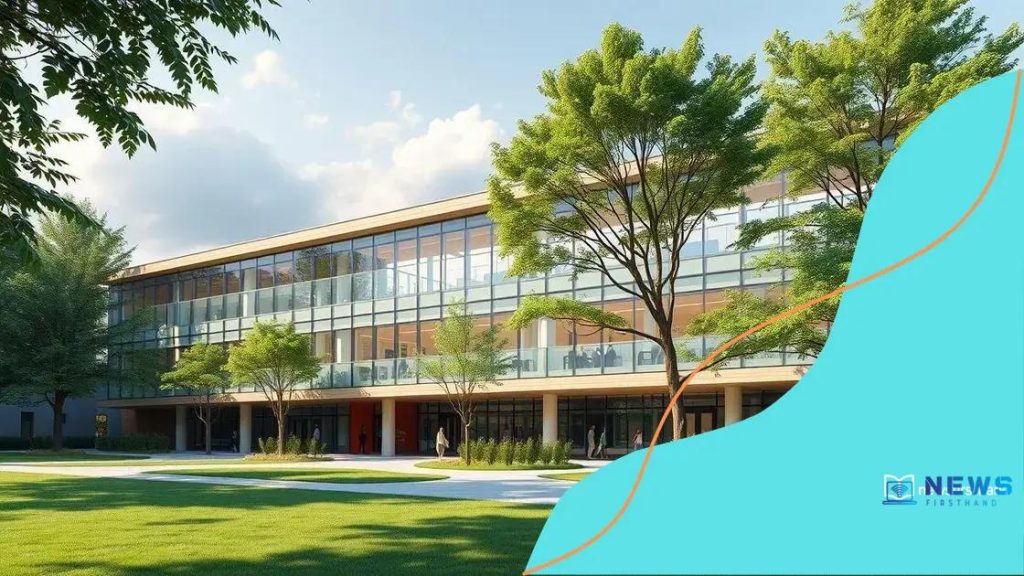School infrastructure: essential elements for modern education

School infrastructure encompasses essential elements like effective design, technology integration, and community support to enhance student learning while addressing challenges such as budget constraints and aging facilities.
School infrastructure plays a pivotal role in shaping educational experiences. Think about how a well-designed space can inspire students and facilitate effective learning. So, what makes school infrastructure so important?
The importance of school facilities
Understanding the importance of school facilities is crucial for enhancing student learning and overall educational outcomes. Well-designed spaces not only promote safety but also foster an engaging environment for students and teachers alike.
Impact on Learning
Quality school facilities directly influence how students perform academically. Research shows that students in well-maintained schools achieve better results. This makes it essential for schools to invest in their facilities to create an optimal learning atmosphere.
Key Benefits of Modern School Facilities
- Enhanced Learning Environment: Modern facilities provide resources that inspire creativity.
- Increased Safety: Up-to-date safety measures protect students and staff.
- Community Engagement: Attractive school buildings can encourage community support and involvement.
Additionally, when students feel comfortable in their surroundings, they are more likely to participate and stay focused. Factors like natural light, open areas, and technological integration contribute significantly to how students engage with their education.
The design of school infrastructure can also enhance collaboration among students. Classrooms that encourage group work and interaction promote teamwork skills, which are essential for future success.
Maintenance and Upgrades
It’s not just about having modern facilities; regular maintenance is key. Schools need ongoing support to keep facilities in excellent condition. Parents and the community must understand that funding for school facilities is an investment in their children’s future.
In essence, investing in school infrastructure is investing in students’ potential. Better school facilities lead to improved student outcomes, making it a priority for educational institutions.
Key elements of effective school infrastructure
Effective school infrastructure is built on several key elements that together create a conducive learning environment. When looking at what makes schools thrive, it’s important to highlight these essential components.
Space Design
The design of spaces in a school greatly influences student engagement. Classrooms that are spacious and well-lit not only make learning more enjoyable but also improve concentration levels. Flexibility in classroom layouts allows for various teaching methods, making lessons more interactive.
Technology Integration
Technology plays a vital role in modern education. Schools should be equipped with the latest technology that enhances learning experiences. This includes smart boards, personal devices for students, and robust internet access. Technology helps in engaging students and facilitating better communication between teachers and learners.
- Smart Classrooms: Equipped with digital tools for interactive learning.
- Access to Resources: Online libraries and educational platforms expand opportunities.
- Communication Tools: Applications to keep parents updated.
Another important aspect is the quality of basic facilities. Adequate restrooms, clean drinking water, and well-maintained common areas contribute to a healthy school environment. When students have access to essential amenities, it helps them focus better on their studies.
Safety is also a major consideration. Schools must ensure that they have secure entry points, surveillance systems, and emergency protocols in place. A safe environment allows students to learn without fear, which is essential for effective education.
Community Involvement
Community support can amplify the effectiveness of school infrastructure. When parents and local organizations are involved, it fosters a sense of ownership. This involvement can lead to additional resources and support for various initiatives. Schools can benefit from partnerships with local businesses and community members, enhancing facilities and opportunities.
How design influences learning outcomes

The design of a learning environment has a profound impact on educational outcomes. A well-thought-out design can enhance student engagement and motivation. In classrooms that promote creativity and collaboration, students are more likely to participate actively in their learning.
Spatial Arrangement
How furniture is arranged can make a difference. Flexible seating arrangements allow students to work in groups or independently. When students can choose where to sit, they feel more comfortable and can focus better on their tasks.
Natural Elements
The inclusion of natural elements like plants and natural light can greatly improve concentration and reduce stress. Classrooms with ample natural light help create a positive atmosphere, making it easier for students to stay alert and engaged. Having a connection to nature, even through window views, can boost well-being.
- Views of Nature: Students who see trees or gardens perform better academically.
- Eco-friendly Materials: Sustainable designs create a healthy learning environment.
- Comfortable Acoustics: Reducing noise levels helps in maintaining focus.
Moreover, the colors used in classroom designs can affect mood and energy levels. Bright colors can energize students, while softer tones encourage calmness and focus. The aesthetics of the classroom can significantly influence how students feel, which in turn impacts their learning.
Technology also plays a key role in modern classroom design. Interactive boards and digital tools can create a more engaging atmosphere. These tools help in visualizing concepts, making learning more interactive and fun. When students can manipulate digital content, they better understand the material.
Safety and Accessibility
Safety and accessibility features are essential in effective design. Classrooms should be easily navigable for all students, including those with disabilities. Safety measures like clear pathways and emergency exits are crucial, ensuring that all students feel secure in their learning environment.
Technology integration in modern classrooms
Technology integration in modern classrooms is essential for enhancing the learning experience. With the advancement of digital tools, schools are transforming how they deliver education, making lessons more interactive and effective.
Interactive Learning Tools
One major aspect of this integration is the use of interactive learning tools. Smart boards and tablets enable students to engage with content in a hands-on manner. This technology allows for real-time feedback, which helps teachers assess student understanding instantly.
Online Learning Platforms
Many classrooms now utilize online learning platforms. These platforms provide access to a variety of educational resources, including videos, quizzes, and forums for discussion. Students can learn at their own pace and revisit materials as needed. This flexibility enhances their understanding and retention of information.
- Virtual Classrooms: Platforms like Zoom or Google Classroom facilitate real-time learning.
- Resource Sharing: Teachers can share materials easily for enhanced collaboration.
- Access to Experts: Students can connect with professionals worldwide through online seminars.
In addition to engagement, technology also helps cater to different learning styles. Visual learners benefit from videos and infographics, while auditory learners can access podcasts and discussions. This diversity enables all students to find methods that work best for them.
A key part of technology in education is encouraging collaboration. Group projects can now be done using shared online documents, allowing students to work together even when they are apart. This collaboration builds essential teamwork skills and prepares students for future workplace environments.
Flipped Classrooms
Moreover, the concept of flipped classrooms has gained popularity. In this model, students learn new content at home through videos and online resources and use classroom time for deeper discussions and hands-on activities. This approach maximizes time with teachers and fosters a more engaging environment.
Challenges in maintaining school infrastructure
Maintaining school infrastructure presents several challenges that schools face regularly. These challenges can affect the quality of education and the safety of students and staff.
Budget Constraints
One major issue is inadequate funding. Many schools operate on tight budgets, which can limit the resources available for maintenance and upgrades. When funds are low, essential repairs may be postponed, leading to deteriorating buildings and facilities.
Ageing Facilities
Another challenge is the age of school buildings. Older facilities often require more repairs and maintenance. These aging structures can have issues such as outdated electrical systems, plumbing problems, and insufficient heating or cooling systems. Investing in renovations can be costly but is necessary for safety and functionality.
- Maintenance Backlog: Delays in addressing repairs can lead to larger problems.
- Compliance Issues: Older buildings may not meet current safety codes.
- Disruption to Learning: Repair works can interrupt classes and activities.
Staffing is also a significant concern. Many schools struggle to find qualified maintenance personnel. This shortage can lead to increased reliance on external contractors, which can be more expensive and less efficient. Limited staff also means that routine maintenance tasks may slip through the cracks, causing further deterioration over time.
Weather conditions can also impact school infrastructure maintenance. Harsh climates can cause wear and tear on buildings. For example, heavy rainfall can lead to flooding and water damage, while extreme cold can cause heating systems to fail. Schools need to prepare for these weather-related challenges to ensure that their infrastructure remains safe and effective.
Community Support
Community support plays a vital role in overcoming some of these challenges. When local organizations and parents are involved, they can help raise funds or volunteer for maintenance projects. This community effort can significantly assist schools in maintaining their facilities and ensuring they provide a safe and conducive learning environment.
FAQ – Frequently Asked Questions About School Infrastructure
What are the main challenges in maintaining school infrastructure?
The main challenges include budget constraints, aging facilities, staffing shortages, and the need for community support.
How does technology integration improve learning?
Technology integration enhances engagement through interactive tools, provides access to online resources, and supports diverse learning styles.
Why is community support important for schools?
Community support helps raise funds, encourage volunteerism for maintenance projects, and fosters a sense of ownership in local education.
What role does safety play in school infrastructure?
Safety is crucial in school infrastructure as it ensures a secure environment for students and staff, promoting better learning outcomes.





